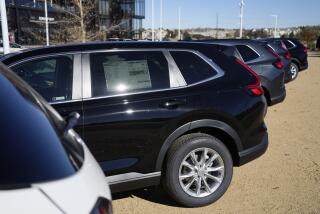Generation X Dream Wheels : The 18-to-30 Crowd Knows What It Wants: A Fully Loaded Sport Utility Vehicle--for $12,000 Please
- Share via
SANTA ANA — They drive tricked-up mini-pickups and beat-up Excels, but they lust after Land Rovers and Explorers.
They want cars that come with sunroofs, telephones, lots of room and sports car-like handling and acceleration. A notable number say amenities such as refrigerators and televisions would be nice too.
A lot of them are like Irvine technical writer Robin Rielley, 30, who recently bought a 1992 Isuzu Rodeo and wouldn’t be caught dead in a minivan, unless she absolutely had to get something bigger.
They are the nation’s 62 million 18-to-33-year-olds, and they are the future of the automobile industry. Detractors lump many of them together as Generation X, a term borrowed from Douglas Coupland’s 1991 novel of the same name (for the more narrowly defined 38-million-member post-baby-boom group born between 1965 and 1975), and they dismiss them as slackers.
But that stereotype of an aimless, goal-less, futureless generation has worn thin over the years. These younger consumers are as productive--and materialistic--as the members of any generation.
And because they account for 28% of U.S. car purchases, auto makers from Detroit to Seoul had best start paying attention to their wants and needs, says George Peterson, president of AutoPacific Inc.
The Santa Ana consulting firm recently completed a survey of what it calls the Automotive Xer generation and found that while they don’t all want the same things from a vehicle, they have very strong opinions about the things they do want.
Indeed, their feelings are considerably stronger than those of older generations of car buyers, and young car owners are far less likely than their older siblings, parents or grandparents to be loyal to a particular manufacturer when they go car shopping.
“What that says is that the manufacturers need to find a way to establish loyalty among these buyers,” Peterson said. “And that means they need to come up with products that meet their needs and are priced competitively, and they need to have sales and service systems that treat (younger buyers) with the same amount of respect that they give to older people.”
The ideal Xer vehicle, said researcher Mary Beth Martin, would be a fully loaded “Jeep Grand Cherokee priced like a Dodge Neon. They want that $30,000 vehicle with the V-8 engine--but they want to pay $12,000 for it.”
In that, Xers really aren’t any different from other age groups, Martin acknowledged. What is different is that they are far less likely to be able to pay $30,000 to get the car they desire.
That’s why a high percentage of Xers drive around in mini-pickups, Peterson said. The vehicles “can be dressed up to be sporty, but they don’t cost so much and the insurance is a lot less” than for the sports cars and sport utility vehicles young buyers really want.
(AutoPacific surveyed 1,740 recent buyers of new and used cars in the 18-33 age group.)
*
The study confirms the auto industry’s suspicion that younger buyers “are definitely attracted to certain products, like compact pickups and compact sport utility vehicles” priced at $25,000 or less, said Morrie Markowicz, spokesman for the Assn. of International Automobile Manufacturers.
Sales of small pickups such as the Ford Ranger have remained fairly stable at about 1 million a year since 1990, according to Automotive News, the weekly trade journal. However, purchases of compact sport utility vehicles have boomed. Sales rose almost 60% in just four years, to 1.2 million units in 1993 from 753,781 in 1990.
Together, sales in those two categories accounted for almost 13% of the market in 1993. And while age-based buyer data isn’t available, manufacturers generally agree that the under-30 crowd gobbles up “a whole lot of them,” Markowicz said.
Buyers born in 1965 or later--what Ford Motor Co. market analysis manager Joel Pitcoff calls the “baby buster generation”--still purchase more cars than light vans and trucks.
Only 38% of younger U.S. auto buyers purchased trucks in 1994, compared to 42.5% for the overall market. Among the buster-generation truck buyers, Pitcoff said, 39% bought compact pickups, 16% bought full-size pickups and 34% bought compact sport utility vehicles such as the Ford Explorer or Isuzu Rodeo.
What baby busters really don’t want are minivans. Only 8% of the under-30 truck buyers purchased small vans; for all age groups, minivans accounted for 19% of 1994 light truck and van sales.
The AutoPacific survey didn’t ask, but in interviews with The Times, many young drivers said they hated the hassle of car shopping and would most likely head for a one-price dealership when the time came to get a new car.
“I’m probably looking at a Saturn,” said Donald Herman, a 32-year-old gift-buying consultant in Los Angeles. He cited cost, practicality and the fact that Saturns are generally sold at the sticker price, without haggling.
Herman said that what he would most like is a convertible. He can’t afford one, though, so his next car--he’s finally getting rid of the Hyundai Excel he bought new in 1987 and has driven for more than 80,000 miles--”definitely has to have a sunroof,” echoing the desires of 65% of the AutoPacific study’s respondents.
Herman was also representative of the study’s findings on the importance of safety equipment. If he could afford it, he says, his next car would have dual air bags--perhaps side air bags as well--and would be equipped with a computer-controlled, anti-skid braking system.
The Hollywood resident wants “a radio that can’t be stolen--my car’s been broken into 13 times--and an air filtration system . . . a cup holder that adjusts so it can hold a regular can of soda or a Big Gulp, lighted mirrors and map lights and a regular-size spare tire. That’s one of the things I like about the Excel.”
Electrically controlled seats, “a lot of ceiling room so my head doesn’t touch” and a cellular phone--complete with a factory-installed antenna--would round out the package, he said.
*
Safety and utility are important to 26-year-old David Halili as well. The Fullerton resident, owner of a graphic arts business in Brea, drives a four-wheel-drive 1992 Toyota 4Runner that he bought used last year.
“I used to be into luxury, like Lexus or Infiniti, but they’re not practical,” he said.
Halili doesn’t see himself buying another personal vehicle for some time, although his choice if he did would not sit well with today’s car makers.
Like many members of his generation, Halili has a love affair with the vehicles of the 1940s and ‘50s.
“If I were going to spend $15,000 or $20,000 on a car again,” he said, “I’d look around for a vintage Chevy Chevelle or maybe a 1957 Bel Air that I could rebuild. I’d like something with a little class.”
Chrysler Corp. has recognized an interest in vintage cars and is toying with the idea of turning its Plymouth Prowler concept car--a modern version of the street hot rods of the early ‘50s--into a production car.
However, it’s unlikely that many Xers would be able to afford one. Industry insiders speculate that retail prices would start at $35,000.
(BEGIN TEXT OF INFOBOX / INFOGRAPHIC)
What They Drive Now Pickup: 26% Mid-size car: 22% Small car: 18% Sports-utility vehicle: 11% Sports / sporty car: 10% Van / minivan: 9% Luxury, large car: 4%
What They Want Next
Sports-utility vehicle: 17% Mid-size car: 10% Sports / sporty car: 8% Pickup: 8% Luxury, large car: 6% Van / minivan: 5% Small car: 2% Don’t know: 44%
Some Features They Want
Sun / moon roof: 65% Automatic transmission: 61% Car phone: 61% Four-wheel drive: 58% Convertible top: 27% Television: 15% Fax machine: 10%






